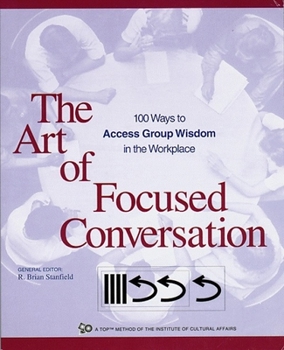The Art of Focused Conversation: 100 Ways to Access Group Wisdom in the Workplace
Select Format
Select Condition 
Book Overview
The best 'how-to' for encouraging consensus in firms and organizations. Communication within many organizations has been reduced to email, electronic file transfer, and hasty sound bytes at hurried meetings. More and more, people appear to have forgotten the value of wisdom gained by ordinary conversations. The Art of Focused Conversation convincingly restores this most human of attributes to prime place within businesses...
Format:Paperback
Language:English
ISBN:0865714169
ISBN13:9780865714168
Release Date:January 2000
Publisher:New Society Publishers
Length:240 Pages
Weight:1.05 lbs.
Dimensions:0.6" x 7.2" x 8.9"
Customer Reviews
4 ratings
Great resource
Published by Thriftbooks.com User , 17 years ago
While the ORID method is reviewed here, it's presented in an easy to follow, pratical approach. Great sample conversations and questions are included in appendicies, bibliograpy is rich with great additional reading references.
An Excellent Resource for Productive Conversations
Published by Thriftbooks.com User , 20 years ago
I like books that are practical and have real-world application. This book does that. You get 48 pages of enough explanation that you can learn how to use the Focused Conversation model. Then, you get the skeleton of 100 conversations that you can adapt and use. If you want to know more, read on. In the 21st century, those workplaces that share information to create value for themselves and their customers have a competitive advantage. On page 14 Stanfield writes "These days most people are tired of blaiming and demanding; they want to solve problems. They want to go beyond input to push an innovation through and take responsibility for making the desired change." The focused conversation model is a technique for capturing the wisdom of a group and helping it become accountable for doing more than complaining or "giving input." The model's four parts consist of asking and answering questions. The questions at the "objective" level begin to uncover facts about the topic being discussed. The "reflective" questions uncover how the group is relating to the facts discussed in the objective level. The "interpretive" level allows the groups to discuss implications and options. The "decisional" level then creates action based on the discussion. This book also contains hints and guidelines for leading focused conversations: what to do when someone gives a long answer, or when people start arguing, or when someone dominates teh conversation...and more. I've used several dozen of the 100 conversations in various work settings. I have gotten especially good value from the conversations on evaluating a seminar, planning a study group, coaching a colleague, mediating a difficult situation, reflecting on a choatic meeting...well, you get the idea. If you're interested in moving toward gathering, processing, and taking advantage of group wisdom, this book provides excellent tools. Its straight-forward, gentle manner and high practical value earn it five stars.
Good Solid Model
Published by Thriftbooks.com User , 23 years ago
Ultimately conversations are the working process of most leadership. This book expands upon the conversation techniques presented in "Winning Through Participation". The model is simple and useful. When distilled down, a focused conversation proceeds through four stages:- objective / data- reactional / feeling- interpretive / meaning and - decisional / action.The model takes about 50 pages to explain and is followed by about 150 pages of examples of its application. Many will find that the 10 pages in "Winning Through Participation" had enough information to get going.
Simple and Powerful Concept
Published by Thriftbooks.com User , 24 years ago
Brian Stanfield and colleagues have written a meaningful book that provides a profound, yet simple method to help groups effectively grapple and address any kind of issue.In the book, they say, "For whole systems to operate effectively, information must flow in every direction, up, down, sideways, and diagonally." They go on to describe leaders as askers of questions and state that "the participatory principle requires the art of asking questions."Canada's Institute of Cultural Affairs developed the focused conversation method as part of its Technology of Participation, which leads people through certain phases of reflection, enabling them to process their experiences as a group. A leader/facilitator asks a series of questions to elicit responses that take a group from the "surface of a topic to a topic to its depth implications for their life and work."The focused conversation uses questions at four levels:1. The Objective Level- questions about facts and external reality. 2. The Reflective Level - questions to call forth immediate personal reaction to the data, an internal response, sometimes emotions or feelings, hidden images and associations with the facts, when we encounter an external reality (data/objective) we experience an internal response. 3. The Interpretive Level - questions to draw out meaning, values, significance, and implications. 4. The Decisional Level - questions to elicit resolution, bring the conversation to close, and enable the group to resolve about the future.The first third portion of the book provides an understanding of the concept of focused conversation and is followed by 100 meeting topics with specific examples of questions at the four levels that would be appropriate.The book has helped me to re-think the types and the order of questions that I address to a group.





